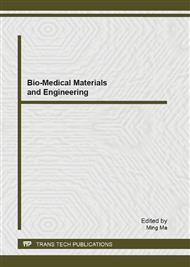p.99
p.106
p.110
p.118
p.125
p.131
p.139
p.144
p.149
Research on the Extraction Methods of Polyhydroxyalknoates and its Thermal Property
Abstract:
To extract PHAs which produced by Bacillus cereus, three methods were used in this article, such as chloroform extraction, chloroform-hypochlorite dispersion extraction and hypochlorite-surfactant extraction. Also the thermal processing performance of the materials was examined. The results showed that chloroform-hypochlorite dispersion extraction was the optimum method. The PHAs isolated had the molecular weight 5.0×105 and the extraction rate was up to 72.4%. The thermal property of these materials was studied by differential scanning calorimetry (DSC) and thermogravimetric analysis (TGA). The result showed that the materials extracted by three methods were all of good thermal processing performance. The processing temperature was forecasted as 220°C.
Info:
Periodical:
Pages:
125-130
Citation:
Online since:
August 2013
Authors:
Keywords:
Price:
Сopyright:
© 2013 Trans Tech Publications Ltd. All Rights Reserved
Share:
Citation:


